Ashby Computers and Graphics Limited, trading as Ultimate Play the Game, was a British video game developer and publisher, founded in 1982, by ex-arcade video game developers Tim and Chris Stamper. Ultimate released a series of successful games for the ZX Spectrum, Amstrad CPC, BBC Micro, MSX and Commodore 64 computers from 1983 until 1987. Ultimate are perhaps best remembered for the big-selling titles Jetpac and Sabre Wulf, each of which sold over 300,000 copies in 1983 and 1984 respectively, and their groundbreaking series of isometric arcade adventures using a technique termed Filmation. Knight Lore, the first of the Filmation games, has been retrospectively described in the press as "seminal ... revolutionary" (GamesTM), "one of the most successful and influential games of all time" (X360), and "probably ... the greatest single advance in the history of computer games" (Edge).

Sabre Wulf is an action-adventure game released by British video game developer Ultimate Play the Game for the ZX Spectrum home computer in 1984. The player navigates the pith-helmeted Sabreman through a 2D jungle maze while collecting amulet pieces to bypass the guardian at its exit. The player does not receive explicit guidance on how to play and is left to decipher the game's objectives through trial and error. Sabreman moves between the maze's 256 connected screens by touching the border where one screen ends and another begins. Each screen is filled with colourful flora, enemies that spawn at random, and occasional collectibles.

Jetpac is a shooter video game developed and published by Ultimate Play the Game and released for the ZX Spectrum and VIC-20 in 1983 and the BBC Micro in 1984. It is the first game to be released by Ultimate Play the Game, the company which later became Rare. The game follows Jetman as he must rebuild his rocket in order to explore different planets, while simultaneously defending against hostile aliens. It was written by Ultimate co-founder Chris Stamper with graphics designed by his brother, Tim Stamper. Reviewers praised Jetpac's presentation and gameplay, and it won "Game of the Year" at the Golden Joystick Awards in 1983.

Cookie is a cooking-themed shoot 'em up developed and published by Ultimate Play the Game that was released exclusively for the ZX Spectrum in 1983. In the game, Charlie the Chef has to bake a cake, however his five ingredients are sentient and attempt to escape his pantry, enabling his quest to re-capture them. The game was written by Chris Stamper with graphics by Tim Stamper. It received mixed reviews upon release, with critics praising the graphics, but criticising the hard difficulty and its similarities to Pssst.

Knight Lore is a 1984 action-adventure game developed and published by Ultimate Play the Game, and written by company founders Chris and Tim Stamper. The game is known for its use of isometric graphics, which it further popularized in video games. In Knight Lore, the player character Sabreman has forty days to collect objects throughout a castle and brew a cure to his werewolf curse. Each castle room is depicted in monochrome on its own screen and consists of blocks to climb, obstacles to avoid, and puzzles to solve.
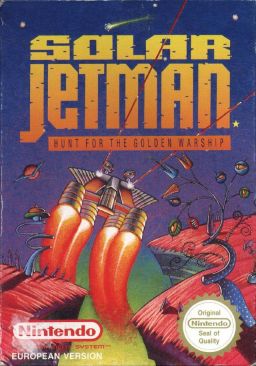
Solar Jetman: Hunt for the Golden Warpship is a multi-directional shooter video game developed by Zippo Games and Rare and published by Tradewest in North America and by Nintendo in Europe. It was released in North America on 14 October 1990 and in Europe on 26 September 1991 for the Nintendo Entertainment System. The game is the third installment of the Jetman series and was later re-released by Nintendo for their NES-based PlayChoice-10 arcade system in the United States in 1990.

Underwurlde is a 1984 action-adventure platform video game in the Sabreman series by Ultimate Play the Game for the ZX Spectrum and Commodore 64. The player controls the adventurer Sabreman as he jumps between platforms in a castle and its caverns to find an escape past the exit guardians. Underwurlde features about 600 flip screen areas. Unlike other games of its time, Sabreman is not injured when touched by enemies and is instead knocked backwards. Underwurlde is the second game in the series, between Sabre Wulf and Knight Lore, and released shortly before the latter for the ZX Spectrum in late 1984. Another developer, Firebird, ported the game to the Commodore 64 the next year.
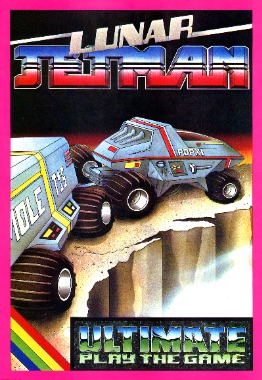
Lunar Jetman is a horizontally scrolling shooter developed and published by Ultimate Play the Game. It was released for the ZX Spectrum in 1983 and later on the BBC Micro. In this sequel to Jetpac, the second instalment of the Jetman series, Jetman has to destroy alien bases whilst simultaneously defending himself, along with Earth, from a hostile alien race.
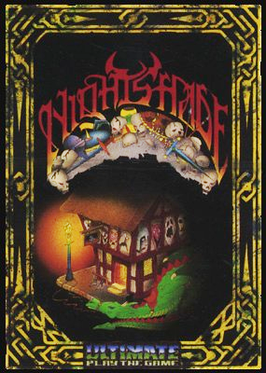
Nightshade is an action video game developed and published by Ultimate Play the Game. It was first released for the ZX Spectrum in 1985, and was then ported to the Amstrad CPC and BBC Micro later that year. It was also ported to the MSX exclusively in Japan in 1986. In the game, the player assumes the role of a knight who sets out to destroy four demons in a plague-infested village.

The Staff of Karnath is an action-adventure video game developed and published by Ultimate Play the Game for the Commodore 64 originally in 1984 and in the United States in 1985. The game is the first instalment of the Pendragon series and is the first to feature the aristocrat adventurer Sir Arthur Pendragon. In the game, Sir Pendragon is tasked with searching a castle for the ancient Staff of Karnath, which he must destroy prior to midnight, before it wipes out the human race.
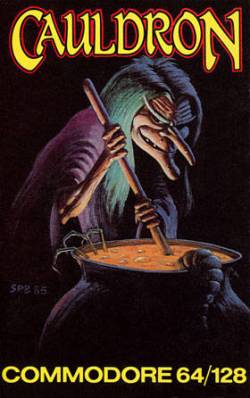
Cauldron is a video game developed and published by British developer Palace Software in 1985 for the ZX Spectrum, Commodore 64, and Amstrad CPC home computers. It contains both platform game and horizontally scrolling shooter sections. Players control a witch who aims to become the "Witch Queen" by defeating an enemy called the "Pumpking".
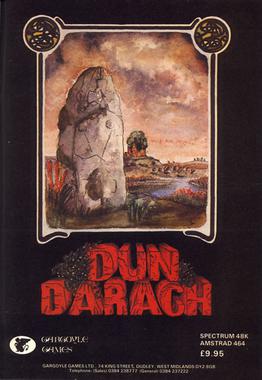
Dun Darach is an arcade adventure developed and published in 1985 by Gargoyle Games for the ZX Spectrum and Amstrad CPC computers. It is a prequel to the 1984 game Tir Na Nog. The plot has Celtic hero Cuchulainn on a search to find his companion Lóeg in the mysterious city of Dun Darach. Inspiration for the game came from the works of Fritz Leiber and Michael Moorcock.

The Evil Dead is an adventure game produced by Palace Software for the Commodore 64, BBC Micro, and ZX Spectrum. Based on the 1981 horror film of the same name, it was the first officially licensed Evil Dead video game. The ZX Spectrum version was never released on its own and eventually appeared on the B-side of Cauldron.
Quicksilva was a British games software publisher active during the early 1980s.
The ZX Spectrum's software library was very diverse. While the majority of the software produced for the system was video games, others included programming language implementations, Sinclair BASIC extensions, databases, word processors, spread sheets, drawing and painting tools, and 3D modelling tools.

Light Force is a 1986 vertically scrolling shooter designed by Greg Follis and Roy Carter, developed by their company Gargoyle Games, and published under their Faster Than Light imprint. It was released for the Amstrad CPC, Commodore 64, and ZX Spectrum platforms.

Rastan Saga, known as Rastan in North America, is a side-scrolling hack and slash arcade video game released by Taito in 1987. It was a critical and commercial success and was ported to home platforms.

Brothers Tim and Chris Stamper are British entrepreneurs who founded the video game companies Ultimate Play the Game and Rare. They first worked together on arcade conversion kits, which were licensed to companies, but later became developers for the ZX Spectrum home computer in the early 1980s. Chris programmed the games, while Tim designed the graphics. They found success as Ultimate with games including Jetpac and Knight Lore. After reverse engineering the Nintendo Entertainment System and deciding to shift their focus to console development, the brothers founded Rare in the mid-1980s. They became Nintendo's first major Western developer, for whom they developed licensed games and ports. Over the next two decades, Rare enjoyed a close relationship with Nintendo and developed multiple major titles for the company, including Donkey Kong Country and GoldenEye 007. Microsoft acquired Rare in 2002, and the brothers left the company in 2007. After spending several years out of the public eye, the brothers are currently planning new ventures.
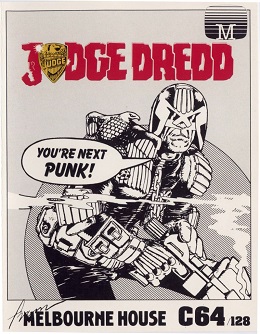
Judge Dredd is a platform shoot 'em up video game based on the character of the same name. It was developed by Beam Software and published by Melbourne House. It was released in Europe in 1986, for Commodore 64 and ZX Spectrum.

















